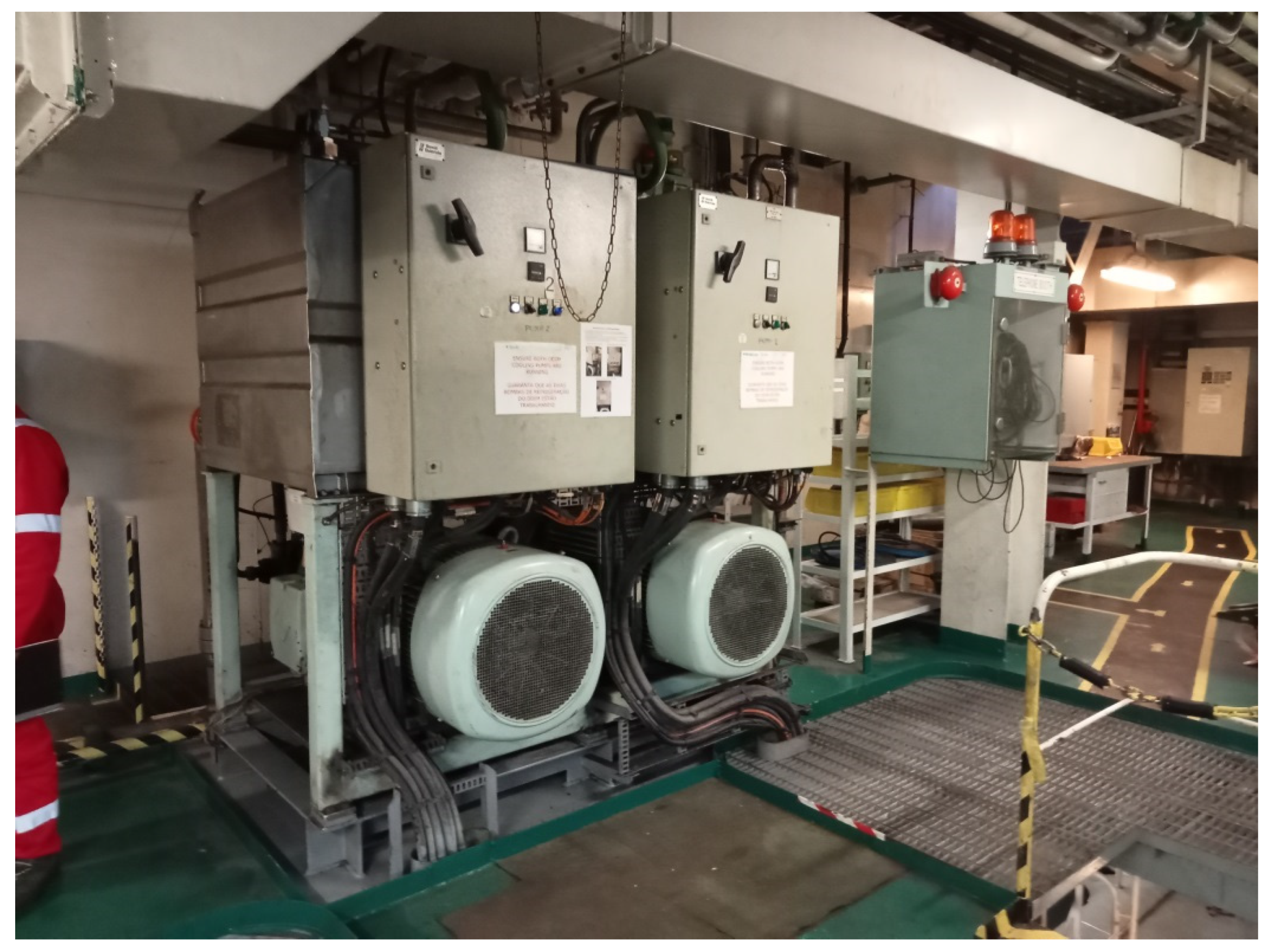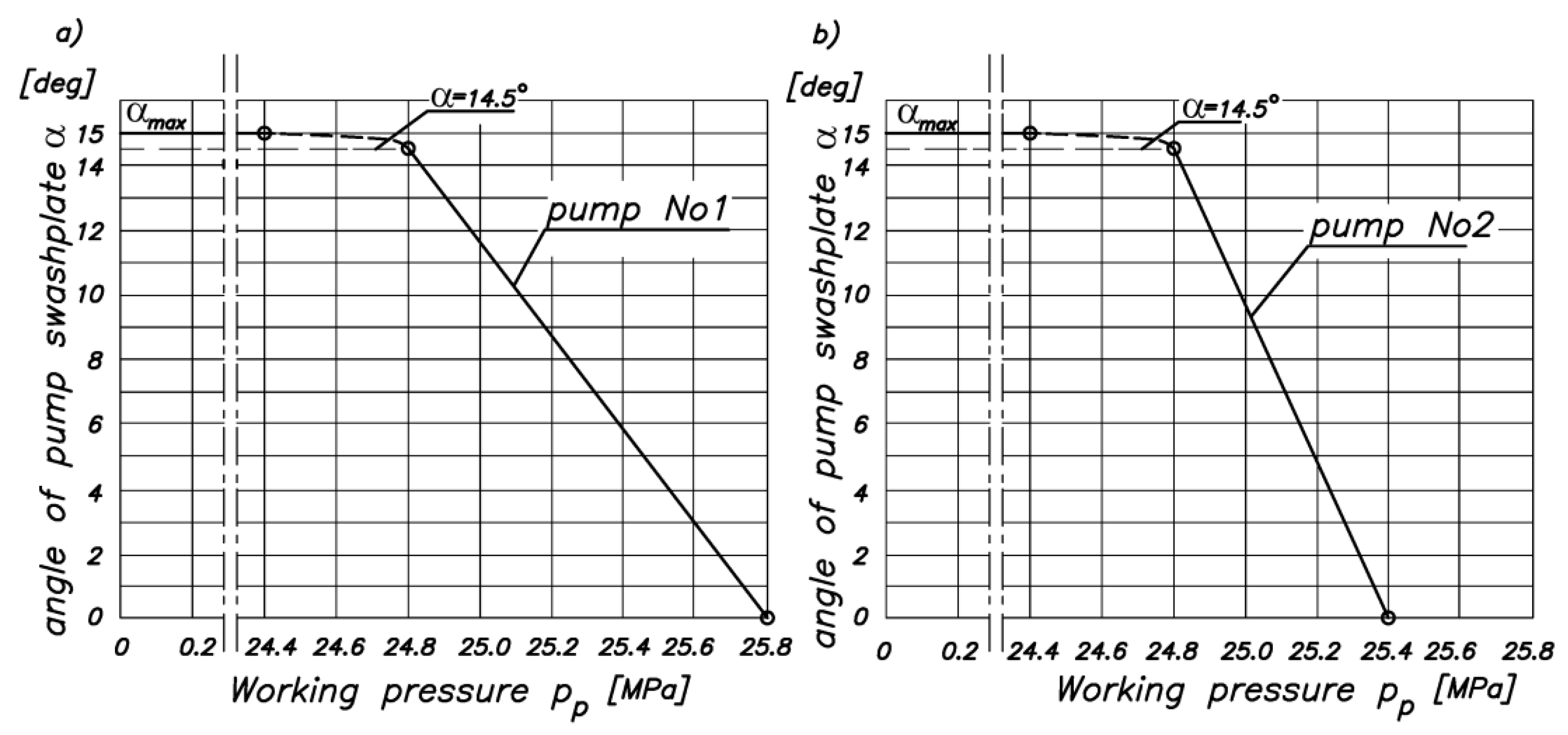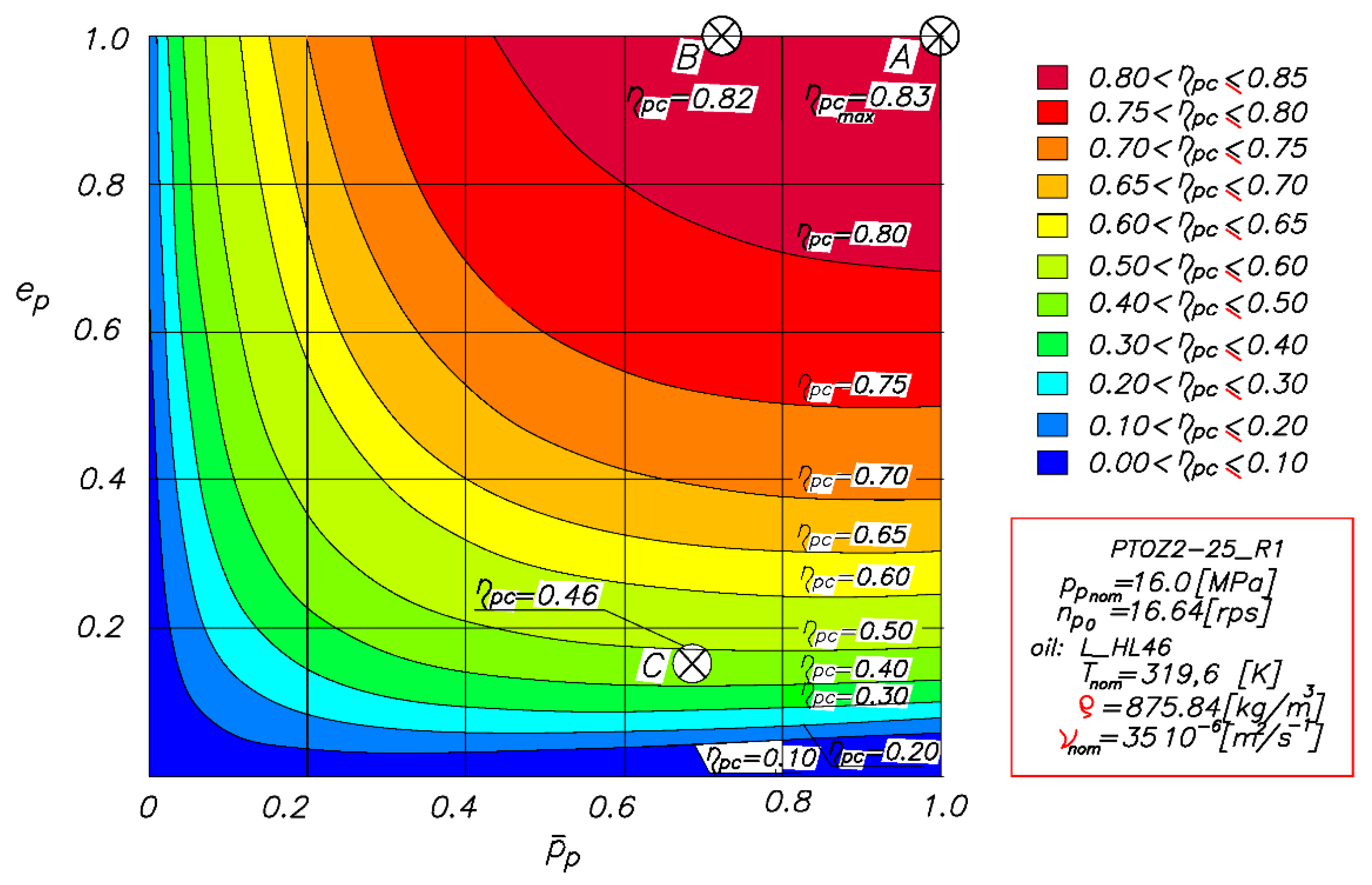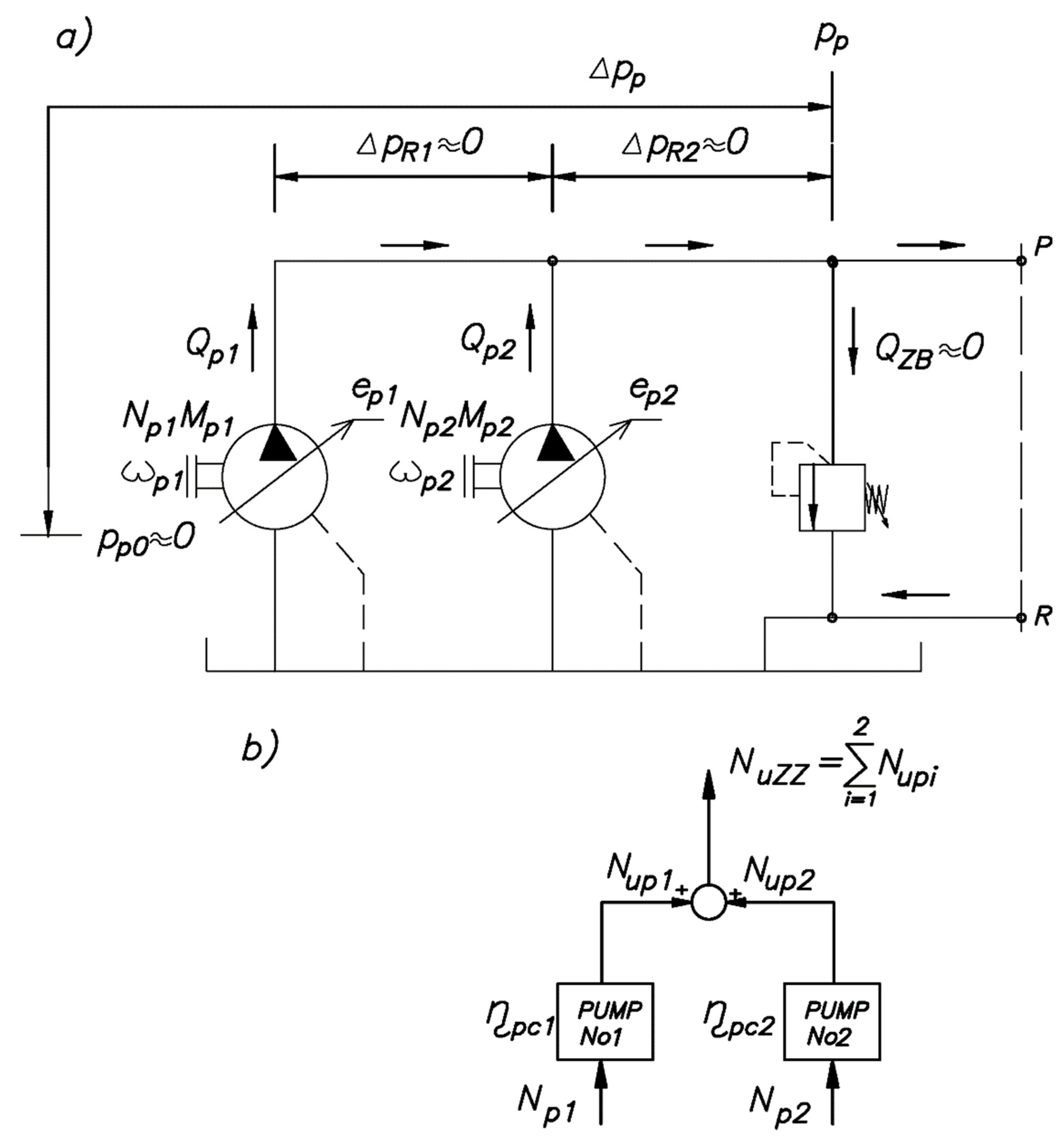Efficiency of a Twin-Two-Pump Hydraulic Power Pack with Pumps Equipped in Constant Pressure Regulators with Different Linear Performance Characteristics
Abstract
1. Introduction
2. Idea of a DP-Type Constant-Pressure Pump Regulator
- —pump discharge pressure;
- —the control pressure, set by the bypass valve of the pressure setter;
- —the lateral surface area of the control distributor spool;
- —the diameter of the spool;
- —the constant of the valve spring;
- —the final and initial lengths of the valve spring;
- —the Coulomb friction force between the slider and the valve body;
- —the hydrodynamic reaction of il on the slider.
3. Efficiency Calculation Model of the Axial Piston Hydraulic Pump with Variable Displacement
- All physical processes occurring in the analyzed pump are of a fixed nature;
- The hydraulic system and the analyzed positive displacement pump are vented (no air in hydraulic oil) and no cavitation phenomena occur during operation;
- The working medium (hydraulic oil) meets the conditions of a Newtonian fluid;
- The oil flow is isothermal and the kinematic viscosity value is fixed, equal to the nominal value recommended by the manufacturer of the hydraulic pump and does not change over time;
- The positive displacement pump is a piston-axial type unit with a pivoting swash plate disk, with an adjustable geometric working volume;
- Slots in the positive displacement pump were not deformed;
- The drive motor of the analyzed pump is a three-phase electric asynchronous motor, (this type of motor is the most widely used in practice);
- The pressure relief valve in the closed state is tight.
- the coefficient of pump relative load :where
- —the nominal pump working pressure.
- the current geometrical volume adjustment of the working volume pump :where
- —the current theoretical and geometrical working volume of hydraulic pump, referring to 1 (one) turnover of the drive pump shaft;
- —the maximum theoretical and geometrical working volume of hydraulic pump, referring to 1 (one) turnover of the drive pump shaft;
- —the current and maximum swashplate angle of the axial-piston pump variable;
- —the theoretical pump flow at and at the nominal speed of the electric motor at the zero-pressure drop between the pump inflow and the outflow:where
- —the rotational speed of the drive electric motor, at the zero-pressure drop between the pump inflow and the outflow and full adjustment of the working geometrical volume .
- —oil pressure measured at the discharge of the positive displacement pump;
- —oil pressure measured at the inflow to the pump;
- —the difference in oil pressure at the discharge and inflow to the pump;
- —the actual capacity of the pump, measured at the pump discharge;
- —drive torque of the pump measured at the drive shaft;
- —the angular velocity of the pump’s drive shaft.
- —the theoretical capacity of the positive displacement pump at a given pump setting ep;
- —pump leakage flow;
- —the theoretical working volume related to one revolution of the positive displacement pump, at the maximum swing of the swashplate disc.
- —the theoretical drive torque of the positive displacement pump at a given theoretical pump operating volume setting ep:where
- Mp—the actual driving torque of the pump;
- Mpmh—the moment of mechanical-hydraulic losses in the pump.
- kpv1, kpv2—coefficients of volume loss in the positive displacement pump, determined at a fixed value of the viscosity of the hydraulic oil in which the tests were performed.
- kpv—the generalized coefficient of volume loss in the positive displacement pump.
- kpmh1, kpmh2, kpmh3, kpmh4, kpmh5, kpmh6—the coefficients of mechanical-hydraulic losses in a displacement pump with variable geometric displacement, determined at a fixed value of drive shaft speed and hydraulic oil viscosity.
4. Axial Piston Pump Efficiency Experimental Test Results
- —the rotational speed of an asynchronous electric motor at zero load torque;
- kpvn—the stiffness coefficient of the drive characteristic of the electric motor driving the positive displacement pump.
- —the speed drop of the drive motor of the positive displacement pump at the nominal relative load of the pump .
5. Efficiency of the Hydraulic Power Pack Unit with Twin-Two-Axial Piston Hydraulic Pumps in the Case of Simultaneous Work in an Open Circuit
- —the total efficiency of the individual pumps of the power units.
6. Conclusions
Author Contributions
Funding
Institutional Review Board Statement
Informed Consent Statement
Data Availability Statement
Acknowledgments
Conflicts of Interest
References
- Banaszek, A.; Petrovic, R. Problem of Non Proportional Flow of Hydraulic Pumps Working with Constant Pressure Regulators in Big Power Multipump Power Pack Unit in Open System. Tech. Gaz. 2019, 2, 294–301. [Google Scholar]
- Banaszek, A. Identification of optimal efficiency exploatation conditions of axial piston hydraulic motor A2FM type using Artificial Neural Network algorithms. Elsevier Procedia Comput. Sci. 2021, 192, 1532–1540. [Google Scholar] [CrossRef]
- Stocznia Szczecinska Design Office SA. Technical Specification 40000 DWT Chemical Tanker Nr B578-I-PK/0050-1-“B”; Stocznia Szczecinska SA: Szczecin, Poland, 1997. [Google Scholar]
- Banaszek, A.; Petrovic, R. Calculation of the unloading operation in case of liquid cargo service with high density on modern product and chemical tankers equipped with hydraulic submerged cargo pumps. Stroj. Vestn. -J. Mech. Engin. 2010, 56, 186–194. [Google Scholar]
- Banaszek, A. The concept of powering of submerged ballast pumps from hydraulic central loading system on board product and chemical tankers. Mar. Technol. Trans. Pol. Acad. Sci. 2007, 18, 5–17. [Google Scholar]
- Bosch Rexroth Group. Catalogue RD 92050/09.21; Bosch Rexroth Group: Lohr am Main, Germany, 2021. [Google Scholar]
- Nollau, R. Interaction of circuits in the central power supply. Hydraul. Pneumatyka 1986, 1, 3–8. [Google Scholar]
- Petrovic, R. Mathematical Modeling and Identification of Multicylindrical Axial Piston Pump Parameters. Ph.D. Thesis, Faculty of Mechanical Engineering, Belgrade, Serbia, 1999. [Google Scholar]
- Halusiak, S. Dynamics of the Lifting Mechanism with Hydrostatic Drive from a Saturated Hydraulic Network with Automatic Control of the Absorption of the Secondary Motor. Ph.D. Thesis, Faculty of Mechanical Engineering KMRNiS, Technical University Lodz, Lodz, Poland, 2004. [Google Scholar]
- Śliwiński, P. Determination of the Theoretical and Actual Working Volume of a Hydraulic Motor—Part II (The Method Based on the Characteristics of Effective Absorbency of the Motor). Energies 2022, 14, 1648. [Google Scholar] [CrossRef]
- Sledziewski, P.; Śliwiński, P. The methodology of design of satellite working mechanism of positive displacement machine. Sci. Rep. 2022, 12, 13685. [Google Scholar] [CrossRef]
- Ivantysyn, J.; Ivantysynova, M. Hydrostatic Pumps and Motors. Principles, Design, Performance, Modelling, Analysis, Control and Testing, 1st ed.; Akademia Books International: New Delhi, India, 2001. (In English) [Google Scholar]
- Watton, J. Fluid Power Systems. Modelling, Simulation, Analog and Microcomputer Control; Longman Higher Education; Prentice Hall: New York, NY, USA; London, UK; Toronto, Canada; Sydney, Australia; Tokyo, Japan, 1989. [Google Scholar]
- Wu, X.; Chen, C.; Hong, C.; He, Y. Flow ripple analysis and structural parametric design of a piston pump. J. Mech. Sci. Technol. 2017, 31, 4245–4254. [Google Scholar] [CrossRef]
- Todić, N.; Savić, S.; Gordić, D.; Petrović, R. Experimental Research of the Hydrodynamic Processes of an Axial Piston Water Hydraulic Pump. Machines 2022, 10, 728. [Google Scholar] [CrossRef]
- Karpenko, M.; Bogdevcius, M. Investigation into the hydrodynamic processes of fitting connections for determining pressure losses of transport. Transport 2020, 35, 108–120. [Google Scholar] [CrossRef]
- Bury, P.; Stosiak, M.; Urbanowicz, K.; Kodura, A.; Kubrak, M.; Malesinska, A. A Case Study of Open- and Closed-Loop Control of Hydrostatic Transmission with Proportional Valve Start-Up Process. Energies 2022, 15, 1860. [Google Scholar] [CrossRef]
- Schlosser, W.M.J.; Hilbrands, J.W. Das theoretische Hubvolumen von Verdrangerpumpen. Olhydraulik Und Pneum. 1963, 7, 133–138. [Google Scholar]
- Schlosser, W.M.J.; Hilbrands, J.W. Das volumetrische Wirkungsgrad von Verdrangerpumpen. Olhydrauli Und Pneum. 1963, 7, 476–496. [Google Scholar]
- Williamson, D.P.; Shmays, D.B. The Design of Approximation Algorithms; Cambridge University Press: Cembridge, UK, 2011. [Google Scholar]
- Mathworks Inc. Matlab ver. R2020b Update 4 (9.9.0.15700001) 64-bit (win64). In Tutorial Book; Mathworks Inc.: Natick, MA, USA, 2020. [Google Scholar]






| Piston Pump Type | Electric Motor Type | qptmax | ppnom | np0 | Qptmax = qptmax• np0 | Mptnom = qptmax• ppnom/2π |
|---|---|---|---|---|---|---|
| •10−3 m3/rot | MPa | rps | •10−3 m3/s | Nm | ||
| PTOZ2-25-R1 | Sg160M-4 | 0.01649 | 16.0 | 16.64 | 0.2744 | 41.99 |
Publisher’s Note: MDPI stays neutral with regard to jurisdictional claims in published maps and institutional affiliations. |
© 2022 by the authors. Licensee MDPI, Basel, Switzerland. This article is an open access article distributed under the terms and conditions of the Creative Commons Attribution (CC BY) license (https://creativecommons.org/licenses/by/4.0/).
Share and Cite
Banaszek, A.; Petrović, R.; Andjelković, M.; Radosavljević, M. Efficiency of a Twin-Two-Pump Hydraulic Power Pack with Pumps Equipped in Constant Pressure Regulators with Different Linear Performance Characteristics. Energies 2022, 15, 8100. https://doi.org/10.3390/en15218100
Banaszek A, Petrović R, Andjelković M, Radosavljević M. Efficiency of a Twin-Two-Pump Hydraulic Power Pack with Pumps Equipped in Constant Pressure Regulators with Different Linear Performance Characteristics. Energies. 2022; 15(21):8100. https://doi.org/10.3390/en15218100
Chicago/Turabian StyleBanaszek, Andrzej, Radovan Petrović, Maja Andjelković, and Milan Radosavljević. 2022. "Efficiency of a Twin-Two-Pump Hydraulic Power Pack with Pumps Equipped in Constant Pressure Regulators with Different Linear Performance Characteristics" Energies 15, no. 21: 8100. https://doi.org/10.3390/en15218100
APA StyleBanaszek, A., Petrović, R., Andjelković, M., & Radosavljević, M. (2022). Efficiency of a Twin-Two-Pump Hydraulic Power Pack with Pumps Equipped in Constant Pressure Regulators with Different Linear Performance Characteristics. Energies, 15(21), 8100. https://doi.org/10.3390/en15218100






